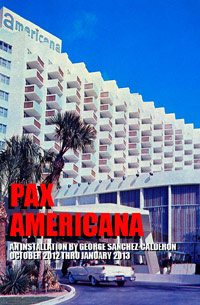Doing It Off Script
Location Location!!


Any real estate agent will tell you that finding the right location is important. Finding the right place to display an artwork, as most collectors and gallerists will tell you, is crucial. One needs to take in to consideration the artworks’ content, size, palette, its backdrop and other artwork surrounding in order to “curate” how the artwork will be perceived and its impact felt.
Conventionally, location is only considered after an artwork is complete. However, making an artwork for a public art commission—that is created uniquely for a pre-existing location—requires an artist to apply an entirely different set of principles that place location, and its conceptual and physical baggage, as the artwork’s primary concern. One could go so far as to say that creating a public artwork actually inverts the creative process. In my opinion, this is what makes public art commissions so exciting and provocative. Whether it be called site specific or site responsive the artist is challenged to interact with the locations social fabric and speak with its public. In essence, a public artwork is a conversation— it embraces, challenges or asks questions about the location’s social, historical and/or political configuration. In some cases its holds a large, shimmering stainless steel mirror up to its onlookers.
Interestingly, looking at the past works of Unscripted Bal Harbour winners George Sánchez-Calderón and Christy Gast, it shares in common the use of public and social space as its base. However their practice does differ. George Sánchez-Calderón’s approach is based on intervention and interaction. In 2001 he created “Le Benedicion/ The Blessing”, a semi permanent recreation of LeCorbusier’s world famous house “Villa Savoye” under bridge of the 395 Interstate in Downtown Miami. By bringing this celebrated architectural design that defined Modernist architecture to the inhabitants of the area and inviting them to interact with the space, he redefined the home’s original meaning and created an inclusive social space that questioned ideas of ownership, access as well as what defines the private and the public.
Artist Christy Gast’s embeds herself within the social and political context of a chosen site, often travelling vast distances to the destination. Then, using the location as her stage, Gast activates herself (or a chosen character) in its landscape. In “Herbert Hoover Dyke” Gast is a tuxedoed tap dancer, tapping her way around the perimeter of Lake Okeechobee using the wall, gates, asphalt and other materials of the dykes’ structure as her soundboard. This action is without a real time audience, so Gast used video and photography to document the performance. However, her primary concern is to interact with the implied social and cultural beliefs and history inherent to the landscape, describing the setting as a “140 mile-long social sculpture.”
It seems fortuitous then that these two seasoned artists have created projects that are deeply rooted in, and activate the physical and cultural landscape of Bal Harbour Village. George Sánchez-Calderón’s roadside “Americana” is a 6’ high stainless steel sign that graces the front lawn of the St Regis Resort and Spa—the site where the former Americana Hotel once stood. His life-size Levittown House speaks to the postwar expansion of Bal Harbour at a time when William Levitt’s suburban housing projects were taking hold and becoming a symbol of the “American Dream”. Gasts’ “Self Portrait As The Barefoot Mailman” is a life-size bronze sculpture reminiscent of a monument one would find on Bal Harbour’s Founder’s circle, and it stands as a testament to the real character that once walked the beaches of Miami and Bal Harbour seafront through sun, wind and ran to deliver post.
Location it seems is everything.


